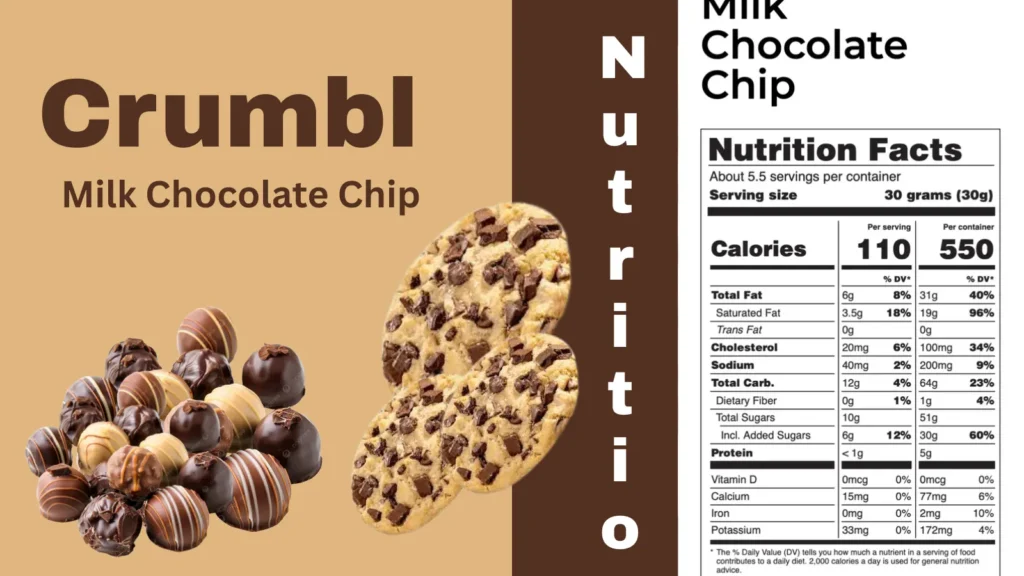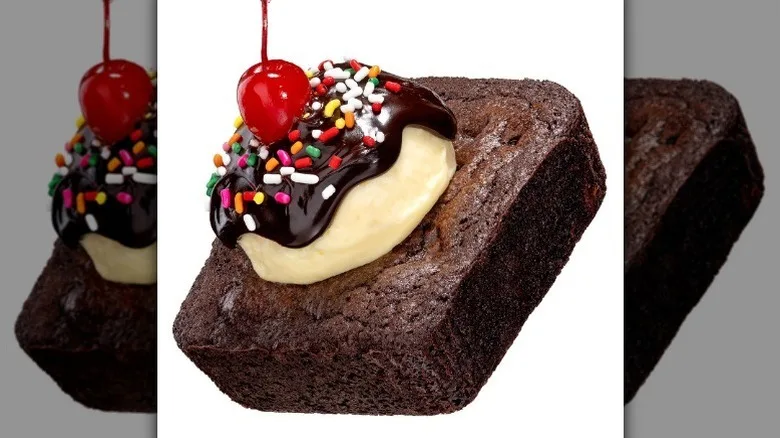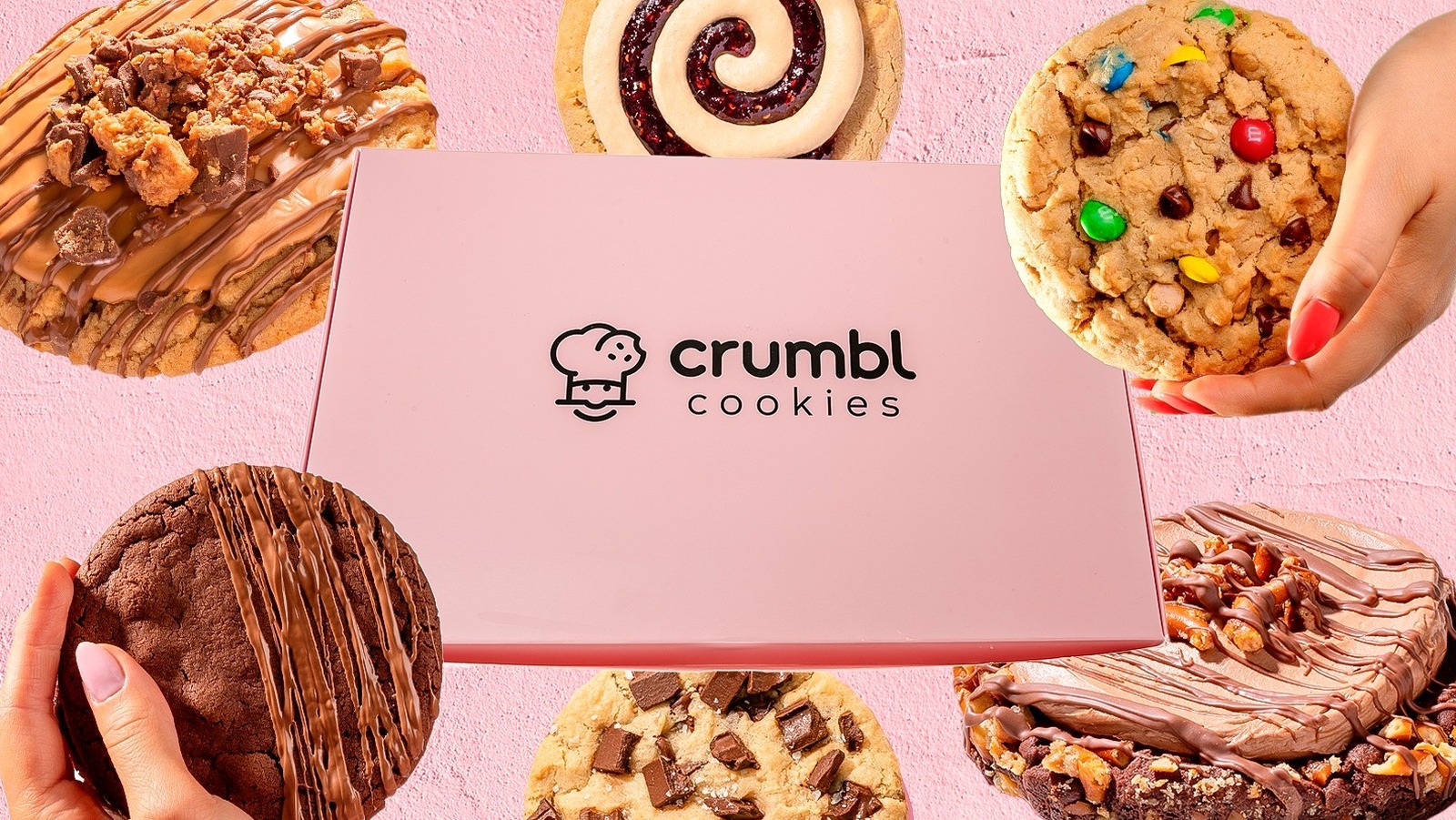Welcome to Tastetrove, your ultimate destination for in-depth reviews, recipes, and nutrition insights on all things delicious. If you’re a cookie lover, you’ve likely heard of Crumbl Cookies – the viral bakery chain that’s taken social media by storm with its oversized, gourmet treats. Among their lineup of rotating flavors, the classic Chocolate Chip Cookie stands out as a staple, often available as the “Milk Chocolate Chip” variant. But what really lies beneath that gooey, chocolate-studded surface? In this comprehensive article, we’ll dive deep into the nutrition facts of Crumbl’s Chocolate Chip Cookie, revealing its shocking 720-calorie count per cookie and breaking down everything from macros to micronutrients. Whether you’re tracking your intake or just curious, we’ll explore the implications for your diet, compare it to other treats, and offer tips for enjoying it mindfully.
As of September 2025, Crumbl continues to dominate the dessert scene with over 1,000 locations across the US and beyond. Their cookies are known for being massive – about 4.5 to 5 inches in diameter and weighing around 156 grams each – making them more like a meal than a snack. The Chocolate Chip Cookie, in particular, features chunks of milk chocolate for a sweeter twist on the traditional semi-sweet version. But with great taste comes great caloric responsibility. According to reliable nutrition databases and Crumbl’s own disclosures, this cookie packs a punch at 720 calories, far exceeding what many expect from a single treat. This revelation has sparked discussions on platforms like Reddit, where users debate the source of those calories and how to fit them into a balanced lifestyle.
In this 2000+ word guide, we’ll cover the full nutrition profile, ingredient analysis, health impacts, and more. If you’re interested in recreating Crumbl-style treats at home with lighter twists, check out our https://tastetrove.net/section. For external resources, visit the official Crumbl Cookies website for the latest flavor updates.
The History and Appeal of Crumbl Cookies
To understand why the Chocolate Chip Cookie’s nutrition is so noteworthy, let’s step back and look at Crumbl’s origins. Founded in 2017 by cousins Jason McGowan and Sawyer Hemsley in Logan, Utah, Crumbl started as a small operation focused on perfecting the chocolate chip cookie. Their mission was simple: create the world’s best box of cookies. What began as a local bakery quickly exploded thanks to clever social media marketing, with weekly flavor rotations keeping customers hooked. By 2025, Crumbl has expanded internationally, with franchises in Canada, Mexico, and even Europe, boasting millions of followers on platforms like Instagram and TikTok.
The Chocolate Chip Cookie has been a constant amid the ever-changing menu, serving as the brand’s signature offering. Unlike standard cookies from brands like Nestlé Toll House, Crumbl’s version uses premium milk chocolate chunks for a creamier, more indulgent bite. This choice contributes to its unique texture – crisp on the edges, soft and chewy in the center – but also amps up the calorie density. Early recipes were tested rigorously, with the founders emphasizing quality ingredients like real butter and high-cocoa chocolate.
Crumbl’s success isn’t just about taste; it’s about the experience. Cookies are baked fresh in open kitchens, packaged in pink boxes, and often shared on social media. However, this popularity has led to scrutiny over nutrition. In 2023, the Center for Science in the Public Interest (CSPI) called out Crumbl for listing calories per “serving” (1/4 cookie) on menu boards, potentially misleading customers into thinking the full cookie is only 180 calories. By 2025, regulations have pushed for clearer labeling, but the 720-calorie reality remains a hot topic. For more on dessert trends, explore our 2025 Dessert Trends article.
The appeal lies in nostalgia mixed with novelty. Chocolate chip cookies evoke childhood memories, but Crumbl elevates them to gourmet status. This balance makes the nutrition facts even more surprising – a treat that feels innocent but delivers a caloric wallop equivalent to a full meal.

Detailed Nutrition Breakdown
Now, let’s get to the heart of the matter: the nutrition facts. Based on data from nutrition tracking sites like FatSecret and Carb Manager, as well as Crumbl’s location-specific disclosures (which can vary slightly due to local sourcing), here’s a comprehensive breakdown for one full Milk Chocolate Chip Cookie (serving size: 1 cookie, approximately 156 grams).
- Calories: 720 (36% of a 2,000-calorie daily diet)
- Total Fat: 32g (41% DV)
- Saturated Fat: 21g (105% DV)
- Trans Fat: 0g
- Cholesterol: 104mg (35% DV)
- Sodium: 360mg (16% DV)
- Total Carbohydrates: 96g (35% DV)
- Dietary Fiber: 4g (14% DV)
- Total Sugars: 52g (includes 28g Added Sugars, 56% DV)
- Protein: 12g (24% DV)
- Vitamins and Minerals:
- Vitamin D: 0mcg (0% DV)
- Calcium: 120mg (9% DV)
- Iron: 3.6mg (20% DV)
- Potassium: 280mg (6% DV)
These values are based on a standard 2,000-calorie diet, as recommended by the FDA. Note that slight variations may occur; for instance, some locations report 730 calories, likely due to minor recipe tweaks or measurement differences.
Breaking it down further, the calories primarily come from fats and carbs. Fat contributes about 288 calories (9 calories per gram), carbs 384 calories (4 per gram), and protein 48 calories (4 per gram). The high saturated fat – over a day’s worth – stems from butter and chocolate, while the sugars provide that addictive sweetness. Dietary fiber is low, meaning this cookie won’t keep you full for long, potentially leading to overeating.
Compared to other data points, Reddit users have noted the serving size confusion, with the full cookie equaling four “servings” of 180 calories each. This tactic, while legal, has been criticized for downplaying the treat’s impact. For micronutrients, the iron content is notable, likely from enriched flour and chocolate, but overall, it’s not a nutrient-dense food. If you’re tracking macros for fitness, this cookie skews heavily toward carbs and fats, making it a poor choice for low-carb diets like keto. For more on macro balancing, see our Macro Diet Guide.
Ingredients Analysis
What makes this cookie so calorie-dense? Let’s examine the ingredients, pieced together from copycat recipes and allergen statements since Crumbl doesn’t publicly list exact formulas. A typical Crumbl Chocolate Chip Cookie includes:
- All-purpose flour (enriched with iron and B vitamins)
- Salted butter (the source of much saturated fat)
- Brown sugar and granulated sugar (contributing to the 52g total sugars)
- Eggs (adding protein and cholesterol)
- Milk chocolate chips (made with sugar, whole milk powder, cocoa butter, chocolate liquor, soy lecithin, and artificial flavor)
- Baking soda and baking powder (for leavening)
- Salt and vanilla extract (for flavor enhancement)
This list aligns with standard chocolate chip recipes but uses premium, high-fat ingredients for that signature richness. The milk chocolate, as opposed to dark or semi-sweet, increases the sugar and dairy content, boosting calories.
Allergens are a key concern: The cookie contains wheat (gluten), milk, eggs, and soy. Crumbl’s open kitchens also process tree nuts and peanuts, so cross-contamination is possible. If you have allergies, always check with your local store or opt for alternatives.
From a quality standpoint, Crumbl avoids trans fats, but the high added sugars (28g, or about 7 teaspoons) exceed half the American Heart Association’s daily limit of 25-36g. Butter provides natural flavor but also saturated fats linked to heart health risks if overconsumed. For healthier swaps, consider our Healthy Cookie Ingredients post. Externally, learn more about sugar guidelines from the American Heart Association.
Health Implications and Comparisons
With 720 calories, indulging in a Crumbl Chocolate Chip Cookie can significantly impact your daily intake. For reference, that’s more than a McDonald’s Big Mac (590 calories) or a slice of pepperoni pizza (around 300 calories). In a 2,000-calorie diet, one cookie represents over a third of your calories, leaving little room for nutrient-rich foods.
Health-wise, the high saturated fat (105% DV) could raise LDL cholesterol levels if eaten frequently, increasing heart disease risk. The 52g of sugars may spike blood glucose, problematic for diabetics or those with insulin resistance. Low fiber means it won’t aid digestion, and the sodium, while moderate at 16% DV, adds up with other processed foods.
Comparisons to other Crumbl flavors reveal similarities: The S’mores Cookie clocks in at around 600 calories, while the Fried Ice Cream variant hits nearly 900. Versus homemade: A standard Nestlé Toll House cookie is about 100 calories – seven times less! Other brands like Insomnia Cookies offer smaller portions at 200-300 calories.
On the positive side, the protein (12g) provides some satiety, and iron supports energy levels. But overall, treat this as an occasional splurge. For balanced eating advice, visit Mayo Clinic’s Nutrition Page. If you’re exploring low-calorie options, our Low-Cal Dessert Ideas might help.
Tips for Enjoying Responsibly
To savor without regret:
- Share one cookie among friends (180 calories per quarter).
- Pair with protein like nuts or yogurt to balance blood sugar.
- Opt for mini versions if available (around 240 calories).
- Track with apps like MyFitnessPal.
- Balance with exercise – a 720-calorie cookie requires about 90 minutes of brisk walking to burn off.
Conclusion
Crumbl’s Chocolate Chip Cookie is a decadent delight, but its 720 calories remind us to indulge wisely. By understanding the nutrition, you can make informed choices. Stay tuned to Tastetrove for more insights, and remember: moderation is key to enjoying life’s sweet moments.
Crumbl Chocolate Chip Cookie Nutrition: 720 Calories Revealed
Welcome to Tastetrove, your ultimate destination for in-depth reviews, recipes, and nutrition insights on all things delicious. If you’re a cookie lover, you’ve likely heard of Crumbl Cookies – the viral bakery chain that’s taken social media by storm with its oversized, gourmet treats. Among their lineup of rotating flavors, the classic Chocolate Chip Cookie stands out as a staple, often available as the “Milk Chocolate Chip” variant. But what really lies beneath that gooey, chocolate-studded surface? In this comprehensive article, we’ll dive deep into the nutrition facts of Crumbl’s Chocolate Chip Cookie, revealing its shocking 720-calorie count per cookie and breaking down everything from macros to micronutrients. Whether you’re tracking your intake or just curious, we’ll explore the implications for your diet, compare it to other treats, and offer tips for enjoying it mindfully.
As of September 15, 2025, Crumbl continues to dominate the dessert scene with over 1,000 locations across the US and beyond. Their cookies are known for being massive – about 4.5 to 5 inches in diameter and weighing around 156 grams each – making them more like a meal than a snack. The Chocolate Chip Cookie, in particular, features chunks of milk chocolate for a sweeter twist on the traditional semi-sweet version. But with great taste comes great caloric responsibility. According to reliable nutrition databases and Crumbl’s own disclosures, this cookie packs a punch at 720 calories, far exceeding what many expect from a single treat. This revelation has sparked discussions on platforms like Reddit, where users debate the source of those calories and how to fit them into a balanced lifestyle.
In this 2000+ word guide, we’ll cover the full nutrition profile, ingredient analysis, health impacts, and more. If you’re interested in recreating Crumbl-style treats at home with lighter twists, check out our Crumbl Copycat Recipes section. For external resources, visit the official Crumbl Cookies website for the latest flavor updates.

The History and Appeal of Crumbl Cookies
To understand why the Chocolate Chip Cookie’s nutrition is so noteworthy, let’s step back and look at Crumbl’s origins. Founded in 2017 by cousins Jason McGowan and Sawyer Hemsley in Logan, Utah, Crumbl started as a small operation focused on perfecting the chocolate chip cookie. Their mission was simple: create the world’s best box of cookies. What began as a local bakery quickly exploded thanks to clever social media marketing, with weekly flavor rotations keeping customers hooked. By 2025, Crumbl has expanded internationally, with franchises in Canada, Mexico, and even Europe, boasting millions of followers on platforms like Instagram and TikTok.
The Chocolate Chip Cookie has been a constant amid the ever-changing menu, serving as the brand’s signature offering. Unlike standard cookies from brands like Nestlé Toll House, Crumbl’s version uses premium milk chocolate chunks for a creamier, more indulgent bite. This choice contributes to its unique texture – crisp on the edges, soft and chewy in the center – but also amps up the calorie density. Early recipes were tested rigorously, with the founders emphasizing quality ingredients like real butter and high-cocoa chocolate.
Crumbl’s success isn’t just about taste; it’s about the experience. Cookies are baked fresh in open kitchens, packaged in pink boxes, and often shared on social media. However, this popularity has led to scrutiny over nutrition. In 2023, the Center for Science in the Public Interest (CSPI) called out Crumbl for listing calories per “serving” (1/4 cookie) on menu boards, potentially misleading customers into thinking the full cookie is only 180 calories. By 2025, regulations have pushed for clearer labeling, but the 720-calorie reality remains a hot topic. For more on dessert trends, explore our 2025 Dessert Trends article.
The appeal lies in nostalgia mixed with novelty. Chocolate chip cookies evoke childhood memories, but Crumbl elevates them to gourmet status. This balance makes the nutrition facts even more surprising – a treat that feels innocent but delivers a caloric wallop equivalent to a full meal.
Detailed Nutrition Breakdown
Now, let’s get to the heart of the matter: the nutrition facts. Based on data from nutrition tracking sites like FatSecret and Carb Manager, as well as Crumbl’s location-specific disclosures (which can vary slightly due to local sourcing), here’s a comprehensive breakdown for one full Milk Chocolate Chip Cookie (serving size: 1 cookie, approximately 156 grams).
- Calories: 720 (36% of a 2,000-calorie daily diet)
- Total Fat: 32g (41% DV)
- Saturated Fat: 21g (105% DV)
- Trans Fat: 0g
- Cholesterol: 104mg (35% DV)
- Sodium: 360mg (16% DV)
- Total Carbohydrates: 96g (35% DV)
- Dietary Fiber: 4g (14% DV)
- Total Sugars: 52g (includes 28g Added Sugars, 56% DV)
- Protein: 12g (24% DV)
- Vitamins and Minerals:
- Vitamin D: 0mcg (0% DV)
- Calcium: 120mg (9% DV)
- Iron: 3.6mg (20% DV)
- Potassium: 280mg (6% DV)
These values are based on a standard 2,000-calorie diet, as recommended by the FDA. Note that slight variations may occur; for instance, some locations report 730 calories, likely due to minor recipe tweaks or measurement differences.
Breaking it down further, the calories primarily come from fats and carbs. Fat contributes about 288 calories (9 calories per gram), carbs 384 calories (4 per gram), and protein 48 calories (4 per gram). The high saturated fat – over a day’s worth – stems from butter and chocolate, while the sugars provide that addictive sweetness. Dietary fiber is low, meaning this cookie won’t keep you full for long, potentially leading to overeating.
Compared to other data points, Reddit users have noted the serving size confusion, with the full cookie equaling four “servings” of 180 calories each. This tactic, while legal, has been criticized for downplaying the treat’s impact. For micronutrients, the iron content is notable, likely from enriched flour and chocolate, but overall, it’s not a nutrient-dense food. If you’re tracking macros for fitness, this cookie skews heavily toward carbs and fats, making it a poor choice for low-carb diets like keto. For more on macro balancing, see our Macro Diet Guide.
Ingredients Analysis
What makes this cookie so calorie-dense? Let’s examine the ingredients, pieced together from copycat recipes and allergen statements since Crumbl doesn’t publicly list exact formulas. A typical Crumbl Chocolate Chip Cookie includes:
- All-purpose flour (enriched with iron and B vitamins)
- Salted butter (the source of much saturated fat)
- Brown sugar and granulated sugar (contributing to the 52g total sugars)
- Eggs (adding protein and cholesterol)
- Milk chocolate chips (made with sugar, whole milk powder, cocoa butter, chocolate liquor, soy lecithin, and artificial flavor)
- Baking soda and baking powder (for leavening)
- Salt and vanilla extract (for flavor enhancement)
This list aligns with standard chocolate chip recipes but uses premium, high-fat ingredients for that signature richness. The milk chocolate, as opposed to dark or semi-sweet, increases the sugar and dairy content, boosting calories.
Allergens are a key concern: The cookie contains wheat (gluten), milk, eggs, and soy. Crumbl’s open kitchens also process tree nuts and peanuts, so cross-contamination is possible. If you have allergies, always check with your local store or opt for alternatives.
From a quality standpoint, Crumbl avoids trans fats, but the high added sugars (28g, or about 7 teaspoons) exceed half the American Heart Association’s daily limit of 25-36g. Butter provides natural flavor but also saturated fats linked to heart health risks if overconsumed. For healthier swaps, consider our Healthy Cookie Ingredients post. Externally, learn more about sugar guidelines from the American Heart Association.
Health Implications and Comparisons
With 720 calories, indulging in a Crumbl Chocolate Chip Cookie can significantly impact your daily intake. For reference, that’s more than a McDonald’s Big Mac (590 calories) or a slice of pepperoni pizza (around 300 calories). In a 2,000-calorie diet, one cookie represents over a third of your calories, leaving little room for nutrient-rich foods.
Health-wise, the high saturated fat (105% DV) could raise LDL cholesterol levels if eaten frequently, increasing heart disease risk. The 52g of sugars may spike blood glucose, problematic for diabetics or those with insulin resistance. Low fiber means it won’t aid digestion, and the sodium, while moderate at 16% DV, adds up with other processed foods.
Comparisons to other Crumbl flavors reveal similarities: The S’mores Cookie clocks in at around 600 calories, while the Fried Ice Cream variant hits nearly 900. Versus homemade: A standard Nestlé Toll House cookie is about 100 calories – seven times less! Other brands like Insomnia Cookies offer smaller portions at 200-300 calories.
On the positive side, the protein (12g) provides some satiety, and iron supports energy levels. But overall, treat this as an occasional splurge. For balanced eating advice, visit Mayo Clinic’s Nutrition Page. If you’re exploring low-calorie options, our Low-Cal Dessert Ideas might help.

Tips for Enjoying Responsibly
To savor without regret:
- Share one cookie among friends (180 calories per quarter).
- Pair with protein like nuts or yogurt to balance blood sugar.
- Opt for mini versions if available (around 240 calories).
- Track with apps like MyFitnessPal.
- Balance with exercise – a 720-calorie cookie requires about 90 minutes of brisk walking to burn off.
